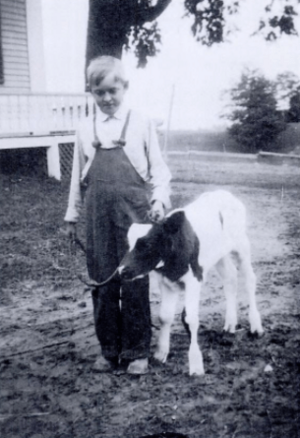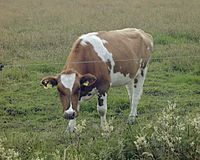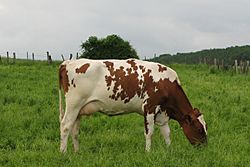Holstein Friesian facts for kids
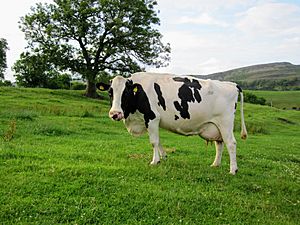
A cow in Yorkshire
|
|
| Other names | Holstein cattle, Friesian cattle |
|---|---|
| Country of origin | Netherlands, Germany, Denmark, Austria, Switzerland, Belgium, France, United Kingdom, Ireland, Italy |
| Distribution | worldwide |
| Use | dairy farming |
| Traits | |
| Weight |
|
| Height |
|
| Coat | black and white pied; also red and white). |
| Horn status | horned, mainly dehorned as calves |
| Notes | |
| originally a dual-purpose breed, used for both dairy and beef | |
|
|
The Holstein Friesian is a very popular type of dairy cattle found all over the world. It first came from the Netherlands and northern Germany. This breed is the most common one used in modern dairy farming in more than 160 countries. It is also known as Holstein, Friesian, or Black and White.
Long ago, when new countries were being settled in North and South America, people needed milk. So, they brought dairy cows from the Netherlands. After about 8,800 Friesian cows were imported, Europe stopped exporting them due to animal diseases.
Today, these cows are used for milk in northern Europe and for meat in southern Europe. After 1945, farming changed. Farmers started raising some animals just for milk and others just for meat. Before this, cows were often used for both. Today, most dairy cows in Europe live north of a line between Bordeaux and Venice.
Because of these changes, farmers in Europe have brought in special dairy Holsteins from the United States. They cross them with their own European black-and-white cows. Now, "Holstein" often means cows from North or South America. "Friesian" usually means cows from traditional European families, used for both milk and meat. When these two types are mixed, they are called "Holstein-Friesian".
Contents
Breed Characteristics
Holsteins are easy to spot because of their unique markings. They are usually black and white, or sometimes red and white. Their patterns are often like patches, called piebald. Rarely, a cow might have both black and red colors with white. This happens because of a special gene called the 'red factor'. Sometimes, they can even look 'blue'. This happens when white hairs mix with black hairs, giving them a bluish tint. Some farmers call this 'blue roan'.
These cows are famous for making a lot of milk. On average, they produce about 10,200 kilograms (22,530 pounds) of milk each year. This milk also contains good amounts of butterfat and protein.
A healthy Holstein calf weighs about 34 to 50 kilograms (75 to 110 pounds) when it is born. A full-grown Holstein cow usually weighs between 680 and 770 kilograms (1,500 and 1,700 pounds). They stand about 145 to 165 centimeters (58 to 65 inches) tall at the shoulder. Young female Holsteins, called heifers, are usually ready to have their first calf when they are 21 to 24 months old. A cow's gestation period, or pregnancy, lasts about nine and a half months.
History of the Breed
Around 100 BC, a group of people from Hesse moved with their cattle to the North Sea coast. They settled near the Frisii tribe. Records suggest these cattle were black, while the Frisii's cattle were white or light-colored. These two types of cattle likely mixed, creating the Holstein-Friesian breed we know today.
The area along the North Sea, called Frisia, was known for its rich land. This land was perfect for raising grass, cattle, and making dairy products. The people there were very good at caring for and breeding cows. Between the 13th and 16th centuries, they produced huge amounts of butter and cheese. Historical records describe their beef cattle as very large, weighing up to 1,360 kilograms (3,000 pounds).
Breeders wanted to get as much milk and meat as possible from the same animal. They used selective breeding, which means choosing the best animals to have babies. This helped them improve the breed a lot. They avoided inbreeding, which is when closely related animals have babies. This helped keep the cows healthy and strong.
In 1282 AD, big floods created the Zuiderzee, a large body of water. This separated the cattle breeders into two groups. One group was in West Friesland, and the other was in the modern-day provinces of Friesland and Groningen in the Netherlands.
Holsteins in the United Kingdom
Before the 18th century, the British Isles brought in Dutch cattle. These cows helped create several new breeds in England and Scotland. Farmers in areas like Yorkshire and near the River Tees used these Dutch and German cows to improve their local cattle.
The Holstein-Friesian breed was common in the lowlands of the Netherlands, Germany, Belgium, and northern France. However, it was not widely used in Great Britain at first. Islands like Jersey and Guernsey had their own special cattle breeds. After World War II, breeders in these islands needed to rebuild their herds. They imported nearly 200 animals, and Canadian breeders even sent three young bulls as a gift.
In Great Britain, the pure Holstein Breed Society started in 1946. It slowly grew until the 1970s, when it became very popular. More animals were imported. In 1999, the Holstein and British Friesian societies joined to form Holstein UK.
Today, Holstein cows have a big influence on dairy cattle in the UK. Many cows are Holstein-Friesian mixes. The term "Holstein" usually refers to cows with North American family lines. "Friesian" refers to traditional European black and white cattle.
Farmers who prefer British Friesians say these cows are very good for farms where cows graze a lot. They believe Friesians live longer and have more calves over their lifetime. This can save money. Male Friesian calves can also be raised for meat, providing extra income for farmers. Friesians are also known for good fertility and strong legs, which means fewer health problems.
Holsteins in the United States
Black and white cattle from Europe first came to the United States between 1621 and 1664. Dutch farmers in New York and Connecticut likely brought cows from their homeland. For many years, these cows were called "Dutch cattle" and were known for producing a lot of milk.
The first official imports happened much later, in 1795. Six cows and two bulls were sent to New York. People described them as "the cows were of the size of oxen, their colors clear black and white in large patches; very handsome". More cows were imported in the early 1800s.
A man named Winthrop W. Chenery from Massachusetts helped bring the breed permanently to the US. He made several importations, starting in 1861. Other important imports followed, which helped create the first Holstein Herd Book, a record of all the purebred animals.
The Trina Holstein breed was started by the Merrill family in Maine in the early 1900s. It began with a cow named "Trina Redstone Marvel." Today, there are many generations of Trina Holstein offspring. After about 8,800 Holsteins were imported, Europe stopped exporting cows due to a cattle disease.
In the late 1800s, Friesian breeders formed groups to keep track of their cows' family trees. These groups joined together in 1885 to create the Holstein-Friesian Association of America. In 1994, its name changed to Holstein Association USA, Inc.
Milk Production
In 2008, Holstein herds in the USA that were part of testing programs produced a lot of milk. On average, they made about 10,440 kilograms (23,022 pounds) of milk, 381 kilograms (840 pounds) of butterfat, and 322 kilograms (709 pounds) of protein each year.
Several things help US Holsteins produce so much milk:
- Some farms milk cows three times a day instead of two. This can increase milk production.
- Most US Holstein herds are 100% Holstein, which means they have a high potential for milk production.
- Many farms use a "total mixed ration" (TMR) feeding system. This means cows get a perfectly balanced mix of food, which helps them produce more milk.
Genetics and Breeding
Over the last 50 years, Holstein breeding has improved greatly. Techniques like embryo transfer have helped multiply the offspring of the best bulls. This allows breeders to test many young bulls to see which ones pass on the best traits.
Famous bulls like Osborndale Ivanhoe (born 1952) helped make Holsteins taller and improved their udders and legs. His descendants, like Round Oak Rag Apple Elevation (born 1965), were also very important. Elevation sired over 70,000 Holstein cattle and is considered one of the most influential bulls ever. Another bull, Penstate Ivanhoe Star (born 1963), had daughters that produced even more milk.
Cloning
Scientists have even been able to clone famous Holstein bulls. For example, Starbuck (2)II, a clone of the well-known bull Hanoverhill Starbuck, was born in 2000. This shows how advanced breeding technology has become. Other important bulls have also been cloned.
Polled Holsteins
The first polled Holstein was found in the United States in 1889. Polled animals are naturally hornless. This is due to a special gene. Historically, this gene was rare in Holsteins. However, because farmers want to avoid dehorning (removing horns from calves), there is growing interest in breeding polled Holsteins.
Red and White Holsteins
Most Holsteins are black and white. But some are red and white. This red color happens because of a recessive gene. If a cow has two copies of this special gene, it will be red and white. If it has only one copy, or no copies, it will be black and white.
History of Red and White Holsteins
In the 13th century, cattle with "broken" colors came to the Netherlands from Central Europe. When Holsteins were first brought to the US (between 1869 and 1885), early breeders decided that only black and white animals would be accepted in the official herd book. They wanted the breed to be known only as Holsteins.
For many years, if a red calf was born to black and white parents, it was often hidden or removed from the herd. This was because breeders wanted to keep their cows' family lines "pure" black and white. However, a few red-carrier animals still existed.
In 1952, a bull used for artificial insemination (AI) was found to carry the red gene. Even though the AI unit warned breeders, many still used him. Slowly, more red-carrier bulls were identified.
In 1964, the Red and White Dairy Cattle Association (RWDCA) started in the United States. This group began registering red and white Holsteins. They had an "open herd book" policy, which meant they accepted these cows. This helped the red and white Holstein become more popular.
Eventually, it became clear that the red trait could not be completely removed. In 1969 and 1970, red and white Holsteins were finally accepted into the Canadian and American herd books. This meant they could be officially registered.
Sometimes, calves are born red and white but then turn mostly black as they grow older. This is known as Black/Red. These cows were sometimes treated differently, but over time, rules have changed to accept them.
Today, red and white Holsteins are a recognized and valued part of the breed.
Notable Holsteins
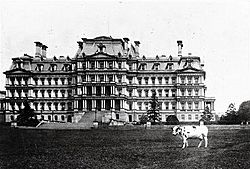
- Ubre Blanca: Fidel Castro's cow, famous for high milk production.
- Pauline Wayne: The cow owned by US President William Howard Taft.
- RORA Elevation: A prize-winning bull, considered one of the most influential Holsteins ever.
- Pawnee Farm Arlinda Chief: A bull known for passing on genes for great milk production.
- Kian: The first red Holstein bull whose semen sold over one million units worldwide.
- Osborndale Ivanhoe: A Holstein bull whose semen was shipped all over the world, used for breeding over 100,000 times.
- Toystory: A Holstein bull whose semen sold over 2.4 million units worldwide, siring an estimated 500,000 offspring.
- Knickers: An extremely large bull from Australia that made headlines for being too big to be processed for meat.
|
See also
 In Spanish: Holstein (raza bovina) para niños
In Spanish: Holstein (raza bovina) para niños



